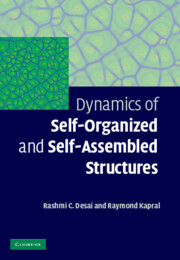Book contents
- Frontmatter
- Contents
- preface
- 1 Self-organized and self-assembled structures
- 2 Order parameter, free energy, and phase transitions
- 3 Free energy functional
- 4 Phase separation kinetics
- 5 Langevin model for nonconserved order parameter systems
- 6 Langevin model for conserved order parameter systems
- 7 Interface dynamics at late times
- 8 Domain growth and structure factor for model B
- 9 Order parameter correlation function
- 10 Vector order parameter and topological defects
- 11 Liquid crystals
- 12 Lifshitz–Slyozov–Wagner theory
- 13 Systems with long-range repulsive interactions
- 14 Kinetics of systems with competing interactions
- 15 Competing interactions and defect dynamics
- 16 Diffusively rough interfaces
- 17 Morphological instability in solid films
- 18 Propagating chemical fronts
- 19 Transverse front instabilities
- 20 Cubic autocatalytic fronts
- 21 Competing interactions and front repulsion
- 22 Labyrinthine patterns in chemical systems
- 23 Turing patterns
- 24 Excitable media
- 25 Oscillatory media and complex Ginzburg–Landau equation
- 26 Spiral waves and defect turbulence
- 27 Complex oscillatory and chaotic media
- 28 Resonantly forced oscillatory media
- 29 Nonequilibrium patterns in laser-induced melting
- 30 Reaction dynamics and phase segregation
- 31 Active materials
- References
- Index
5 - Langevin model for nonconserved order parameter systems
Published online by Cambridge University Press: 10 February 2010
- Frontmatter
- Contents
- preface
- 1 Self-organized and self-assembled structures
- 2 Order parameter, free energy, and phase transitions
- 3 Free energy functional
- 4 Phase separation kinetics
- 5 Langevin model for nonconserved order parameter systems
- 6 Langevin model for conserved order parameter systems
- 7 Interface dynamics at late times
- 8 Domain growth and structure factor for model B
- 9 Order parameter correlation function
- 10 Vector order parameter and topological defects
- 11 Liquid crystals
- 12 Lifshitz–Slyozov–Wagner theory
- 13 Systems with long-range repulsive interactions
- 14 Kinetics of systems with competing interactions
- 15 Competing interactions and defect dynamics
- 16 Diffusively rough interfaces
- 17 Morphological instability in solid films
- 18 Propagating chemical fronts
- 19 Transverse front instabilities
- 20 Cubic autocatalytic fronts
- 21 Competing interactions and front repulsion
- 22 Labyrinthine patterns in chemical systems
- 23 Turing patterns
- 24 Excitable media
- 25 Oscillatory media and complex Ginzburg–Landau equation
- 26 Spiral waves and defect turbulence
- 27 Complex oscillatory and chaotic media
- 28 Resonantly forced oscillatory media
- 29 Nonequilibrium patterns in laser-induced melting
- 30 Reaction dynamics and phase segregation
- 31 Active materials
- References
- Index
Summary
Although the microscopic Hamiltonian contains all of the information needed to describe phase separation kinetics, in practice the large number of degrees of freedom in the system makes it necessary to construct reduced descriptions. Generally a subset of slowly varying macrovariables, such as the hydrodynamic modes, is a useful starting point for theoretical models. The equations of motion of the macrovariables can be derived from the microscopic Hamiltonian, but in practice one often begins with a phenomenological description. The set of macrovariables is chosen to include the order parameter and all other slow variables to which it is coupled. Such slow variables are typically obtained from consideration of the conservation laws and broken symmetries of the system. The remaining degrees of freedom are assumed to vary on a much faster time scale and enter the phenomenological description as random thermal noise. The resulting coupled nonlinear stochastic differential equations for such a chosen “relevant” set of macrovariables are collectively referred to as the Langevin field theory description. In two of the simplest Langevin models, the order parameter ø is the only relevant macrovariable; in model A (introduced in this chapter) it is nonconserved and in model B (described in the next chapter) it is conserved. The labels A, B, etc. have an historical origin from the Langevin models of critical dynamics. The scheme is often referred to as the Hohenberg-Halperin classification scheme (Hohenberg and Halperin, 1977).
Langevin model A
For model A the Langevin description assumes that, on average, the time rate of change of the order parameter is proportional to the thermodynamic force that drives the phase transition.
Information
- Type
- Chapter
- Information
- Dynamics of Self-Organized and Self-Assembled Structures , pp. 32 - 37Publisher: Cambridge University PressPrint publication year: 2009
